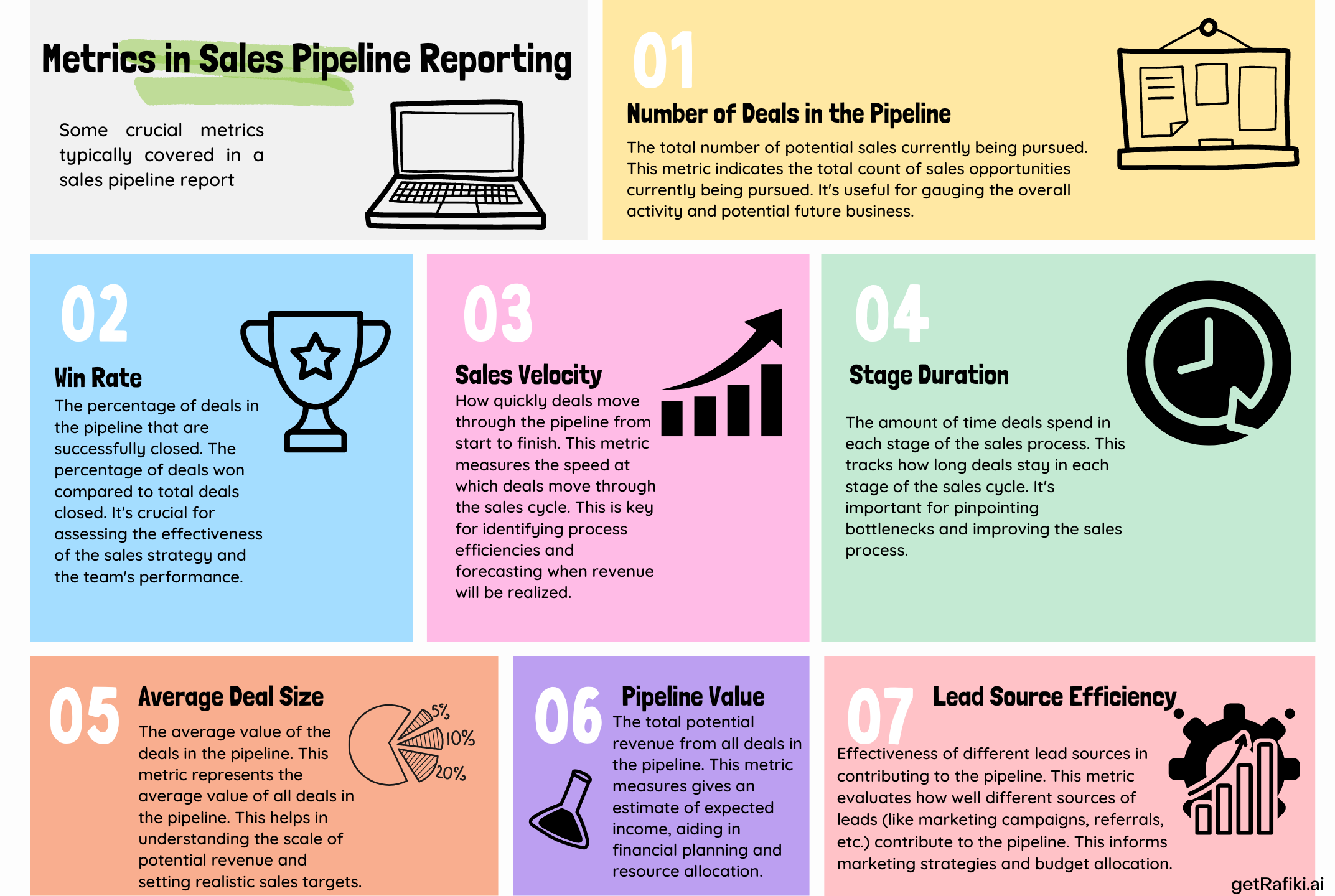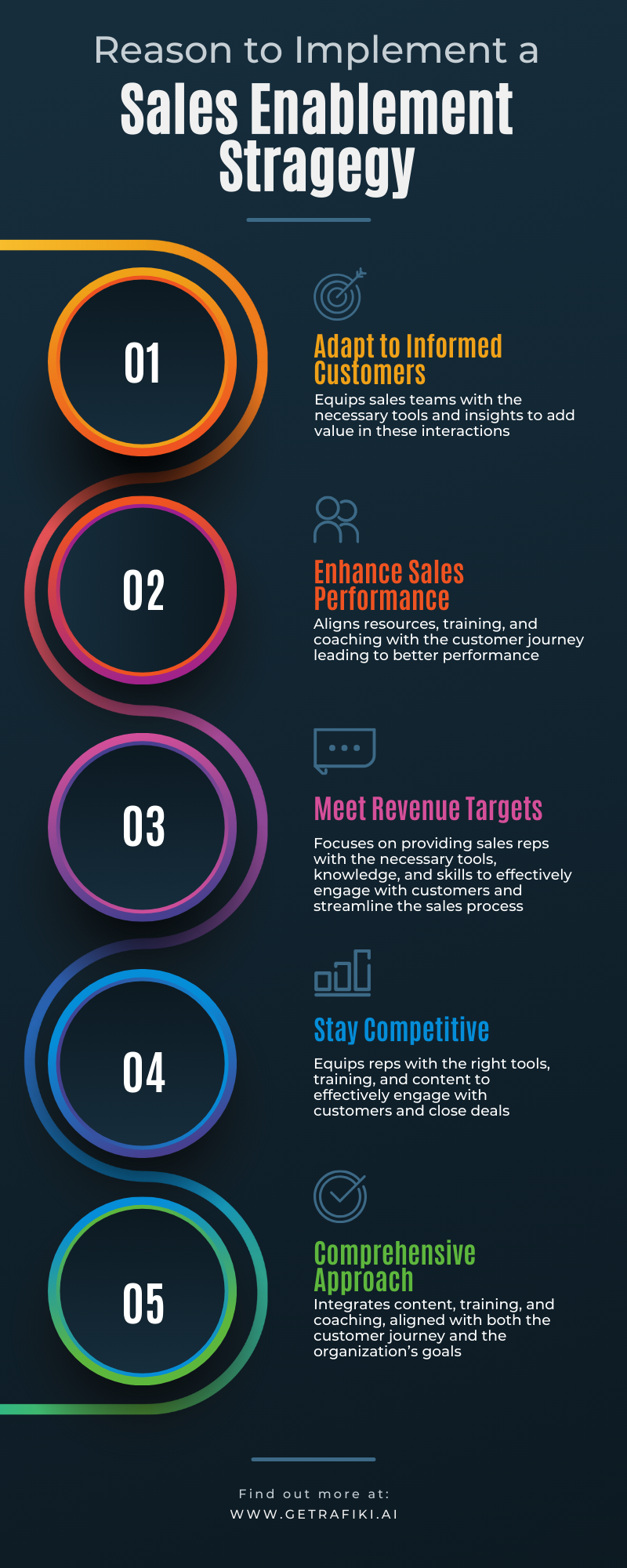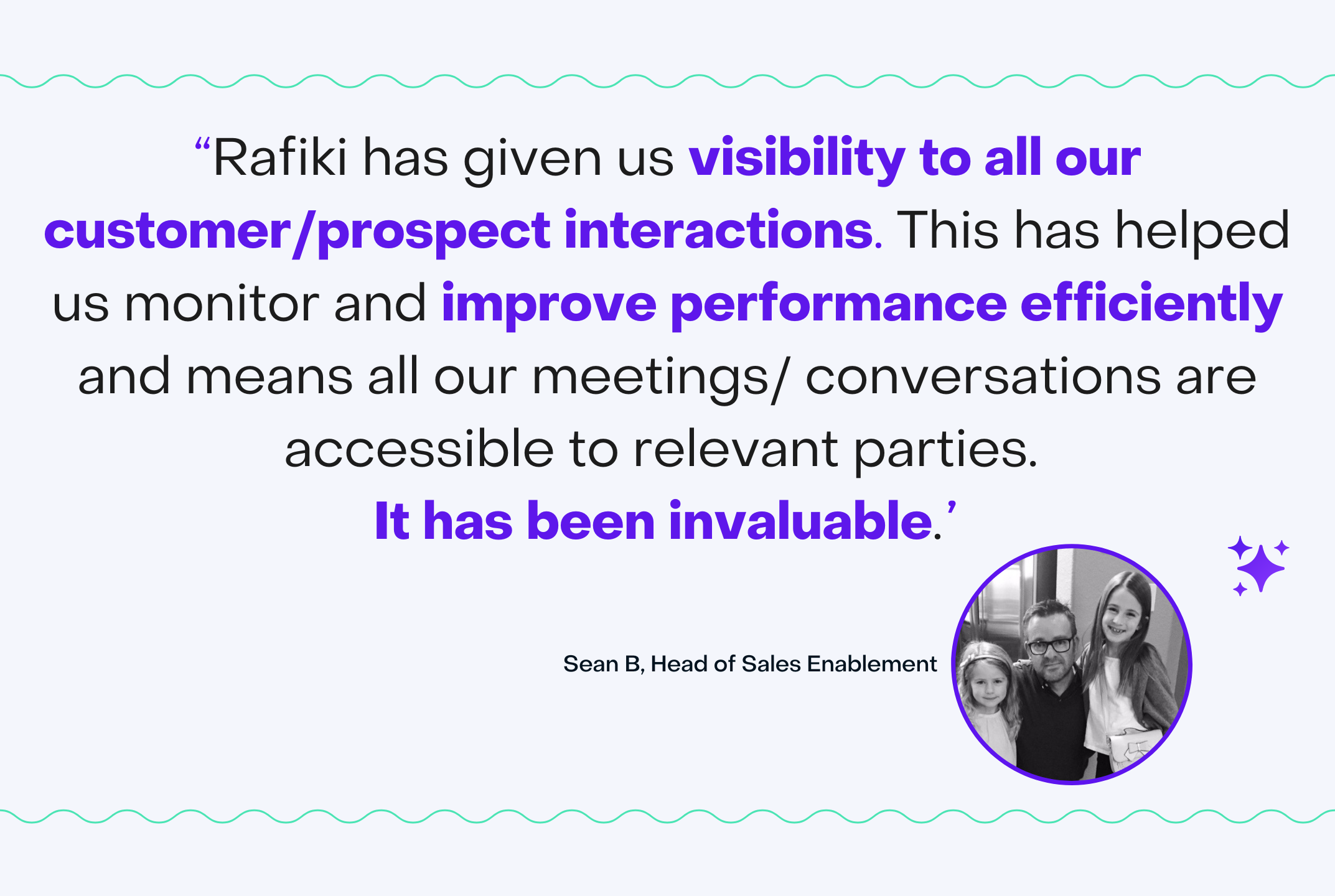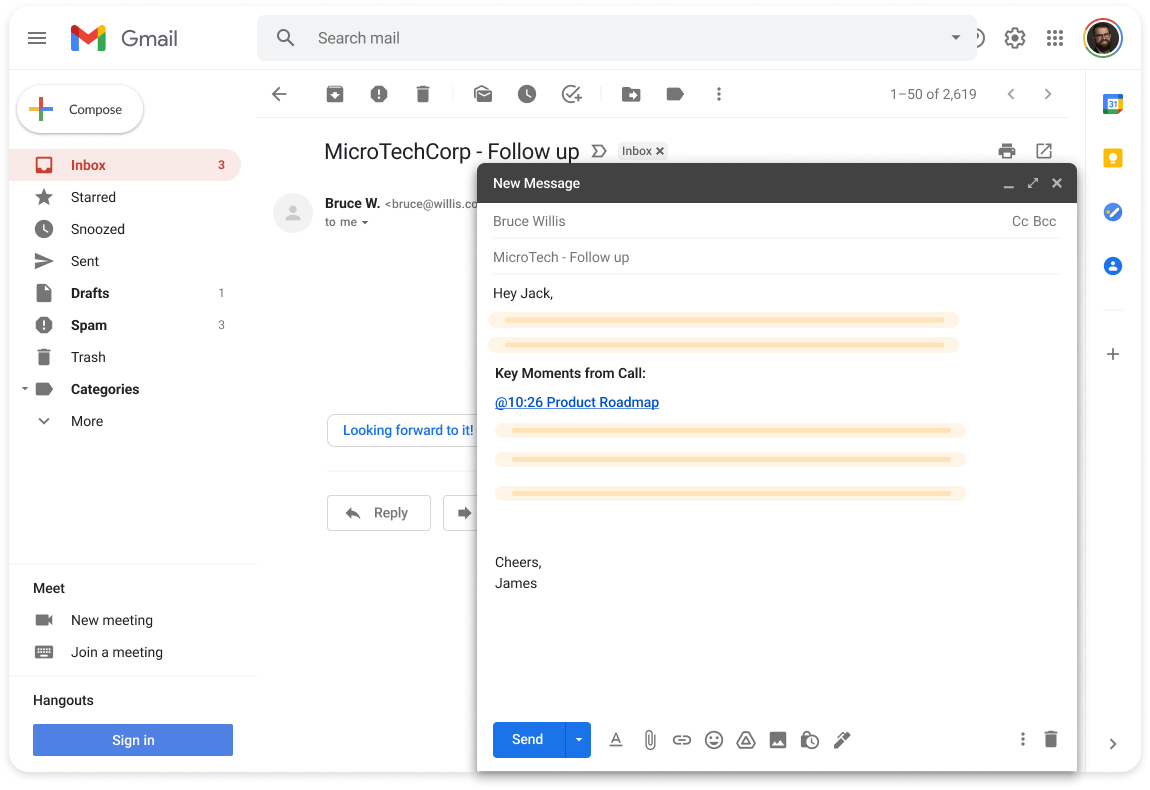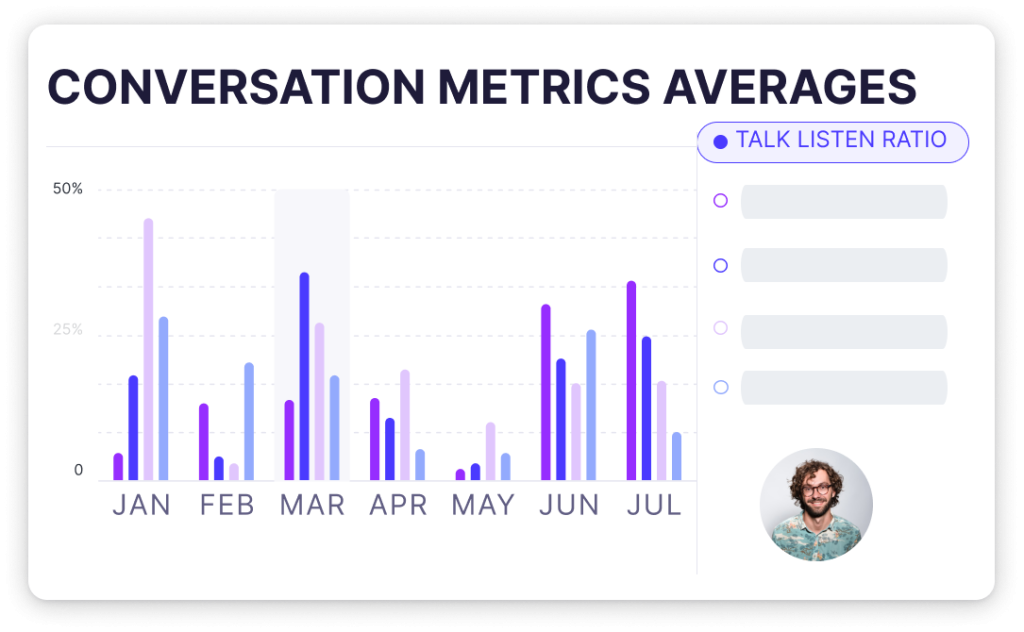7 Steps to Cut Down on Non-Selling Activities
In the fast-paced world of sales, time is not just money—it’s everything. Maximizing the amount of time spent on direct selling activities can dramatically increase the likelihood of meeting and surpassing sales targets. Studies show that top-performing salespeople spend up to 43% more time in front of customers than their peers, highlighting that face-to-face selling directly correlates with sales success. However, sales professionals often find themselves bogged down by a myriad of non-selling activities. From administrative tasks to unnecessarily long meetings, these activities, while sometimes necessary, do not directly contribute to closing deals and generating revenue. Understanding how to identify and reduce these non-selling activities is crucial for sales efficiency and effectiveness.
The goal is to streamline your workflow by reducing the time spent on tasks that do not impact your sales outcomes directly. This not only increases productivity but also allows for more strategic and focused selling efforts. According to a McKinsey report, improving the productivity of salespeople through better time management can lead to a 15-20% increase in sales efficiency.
In this blog, we’ll explore seven practical steps that can help you cut down on non-selling activities, thus freeing up more time for what truly matters—selling. By focusing on these strategies, sales professionals can optimize their daily routines, enhance their performance, and ultimately drive better sales results.
Step 1: Identify Non-Selling Activities
To enhance productivity and focus more on selling, it’s crucial for sales professionals to first identify what constitutes non-selling activities. These are tasks that do not directly contribute to making sales or building customer relationships, yet often consume a significant portion of the workday.
Definition of Non-Selling Activities
Non-selling activities typically include administrative duties, extensive paperwork, and data entry. They also involve internal meetings that do not pertain to active sales strategies. Additionally, managing emails that do not lead directly to sales is included. These tasks maintain the operations of a sales department or organization. However, they do not directly impact sales outcomes. They can detract from time that could be better spent engaging with clients.
Audit and Reduce Non-Selling Activities
To effectively reduce non-selling activities, you first need to conduct an audit of your daily and weekly tasks. This can be done by:
- Tracking Your Time: For a week or two, keep a detailed log of how you spend your workday, noting the time spent on each activity. Tools like time tracking software can automate this process and provide insights into patterns of time expenditure.
- Categorizing Activities: Once you have data on how you spend your time, categorize these activities into selling and non-selling tasks. Be honest and critical about what activities truly lead to sales.
- Evaluating Necessity and Impact: Evaluate the necessity and impact of each non-selling task. Ask yourself if the task contributes indirectly to sales or if it could be streamlined, delegated, or eliminated.
Strategic Elimination
After identifying and categorizing non-selling activities, the next step is to determine which tasks can be eliminated or redesigned to be more efficient. Consider whether:
- The task can be automated using technology.
- The task can be delegated to administrative or support staff.
- The frequency of the task can be reduced without impacting overall business operations.
By identifying non-selling activities and understanding how they fit into your daily routine, you can begin to make informed decisions about how to reduce these tasks or handle them more efficiently. This initial step is essential in paving the way for a more focused and productive sales strategy, allowing more time to be spent on activities that directly impact sales success.
Step 2: Prioritize Tasks
Effective task prioritization is essential for sales professionals who aim to maximize their productivity and focus on activities that directly lead to sales. One effective tool for managing tasks is the Eisenhower Box, also known as the Eisenhower Matrix. This prioritization strategy helps individuals categorize tasks based on their urgency and importance. It allows them to decide more effectively on which tasks to focus immediately, schedule for later, delegate, or eliminate altogether.
Using the Eisenhower Box
The Eisenhower Box divides tasks into four quadrants:
- Urgent and Important (Do First): These tasks have direct implications on your sales and revenue. Examples include responding to hot leads or resolving issues for existing clients.
- Important but Not Urgent (Schedule): These tasks are crucial for long-term success but do not require immediate action. Setting aside time for strategic planning or relationship building falls into this category.
- Urgent but Not Important (Delegate): These tasks need to be completed soon but can be handled by someone else. Examples might include certain administrative duties or preliminary data entry tasks.
- Neither Urgent nor Important (Eliminate): These are the distractions or low-value activities that should be minimized or removed, such as unnecessary meetings or extensive paperwork not directly tied to sales outcomes.
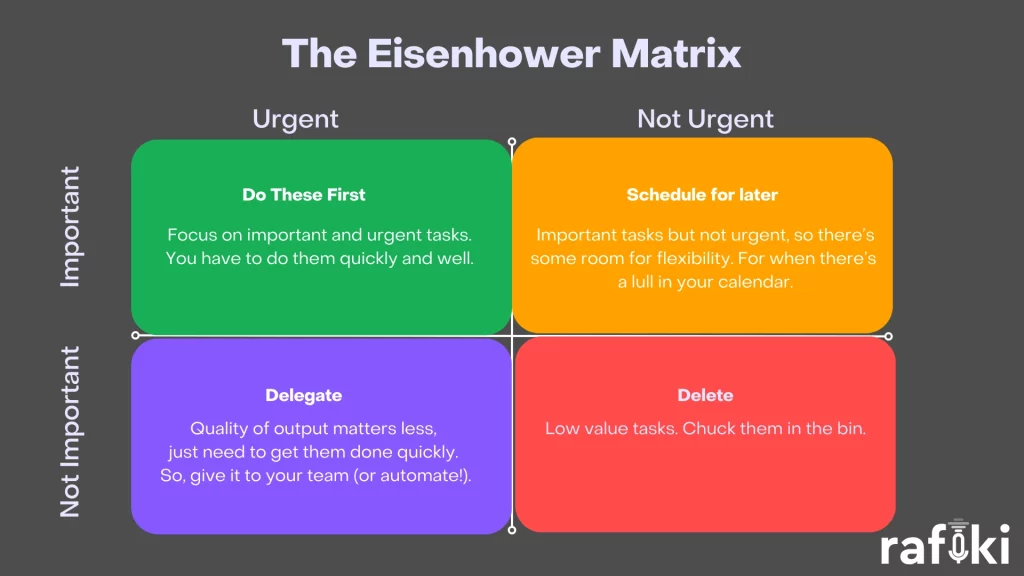
Focusing on Sales-Impacting Activities
After categorizing tasks using the Eisenhower Matrix, focus primarily on tasks that are either urgent and important or important but not urgent. These are the activities that have the most significant impact on your sales goals. By prioritizing these tasks, you ensure that your energy and time are invested in areas that drive sales and contribute to your overall targets.
Moreover, by scheduling important but not urgent tasks, you can plan your workflow in a way that maintains a steady progression towards your goals without last-minute pressures. This strategic approach not only enhances your efficiency but also reduces stress, allowing for a more focused and productive sales process.
Implementing this method of prioritization can transform how you manage your day-to-day activities, leading to significant improvements in performance and sales outcomes. By focusing on what truly matters, you can minimize wasted time. This allows you to channel your efforts towards activities that directly contribute to your success in sales.
Step 3: Automate Routine/Non-Selling Activities
Automating routine tasks is a powerful strategy for sales professionals to increase their efficiency and spend more time on direct sales activities. Modern technology offers a variety of tools that can handle repetitive non-sales tasks, such as CRMs, scheduling apps, and sales intelligence tools. By leveraging these technologies, sales teams can drastically reduce the amount of time spent on administrative tasks.
Automation Tools and Software
- CRM Systems: Customer Relationship Management (CRM) systems are pivotal in automating sales workflows. These systems can automate contact management, sales reporting, and customer interactions, which frees up valuable time for salespeople.
- Scheduling Apps: Scheduling software automates appointment booking and calendar management. This minimizes the back-and-forth often required in scheduling meetings with clients or team members.
- Email Automation Tools: These tools can help manage email campaigns, follow-ups, and even sort incoming emails based on their importance and relevance to sales tasks.
Rafiki: Automating CRM Updates and Call Management
A standout example of automation in the sales process is Rafiki, an advanced tool designed to streamline significant portions of a salesperson’s workflow. Rafiki offers several automation features that specifically reduce non-selling tasks:
- Automatic CRM Updates: Rafiki integrates seamlessly with CRM platforms to automatically push call notes and important meeting details directly into the CRM. This eliminates the need for manual entry after each customer interaction. It ensures that all data is promptly and accurately recorded without extra effort from the sales team.
- Updating Fields from Call Data: Rafiki can analyze conversations and extract key pieces of information, such as client needs or follow-up tasks, and update these fields in the CRM. This feature ensures that the CRM is always up-to-date with the latest data, reducing the likelihood of errors and the need for manual updates.
- Streamlined Call Management: By recording and transcribing sales calls, Rafiki allows sales teams to revisit conversations. This enables them to extract actionable insights without manually reviewing each call. This capability not only saves time but also enhances the quality of customer engagement by pinpointing areas for improvement and follow-up.

Benefits of Automation
Automating these routine tasks can lead to significant benefits:
- Increased Productivity: Sales teams can focus more on engaging with clients and pursuing leads, rather than getting bogged down by paperwork and data entry.
- Enhanced Accuracy: Automated systems reduce human error in data handling, leading to more accurate customer data and insights.
- Better Time Management: Automation helps in managing time more effectively, allocating more resources to strategic sales planning and execution.
By implementing tools like Rafiki, sales professionals can transform their workflow, making it more efficient and effective. Automation not only helps in managing time better but also ensures that every minute spent is directed towards activities that contribute to sales success.
Step 4: Delegate Effectively
Effective delegation is crucial for sales professionals to focus on high-impact activities and enhance team efficiency. It involves identifying tasks that others can handle and assigning them to the right team members. This allows leaders to concentrate on core responsibilities like closing deals and strategizing.
Key Strategies for Effective Delegation
- Identify Delegable Tasks:
- Pinpoint routine and time-consuming tasks that don’t require your specific expertise, such as certain administrative duties or preliminary research.
- Choose the Right Person:
- Assign tasks based on the team member’s skills, interests, and current workload. Ensure the task matches their ability level and helps them grow professionally.
- Set Clear Expectations:
- Clearly communicate the task requirements, desired outcomes, and deadlines. Provide necessary resources and define communication protocols.
- Empower and Trust:
- Allow team members the freedom to complete tasks in their way, fostering independence and innovation. Offer support when needed, but avoid micromanaging.
- Provide Feedback and Recognize Efforts:
- Offer constructive feedback and recognize achievements to encourage continued improvement and motivation.
Benefits of Delegation
Delegating effectively maximizes team productivity and fosters professional development. It helps maintain focus on strategic sales activities while building a supportive and skilled team ready to take on increasing responsibilities.
Step 5: Set Specific Time Blocks
Time blocking is an effective method for managing the day efficiently and enhancing productivity, particularly in sales. By allocating specific time slots to various types of tasks, sales professionals can ensure that they focus adequately on essential activities. This approach also prevents the neglect of necessary administrative duties.
How to Implement Time Blocking
- Assess Your Daily Tasks:
- Review your typical tasks and activities to determine how they can be grouped. Identify periods of the day when you are most productive and align your most demanding sales activities with these times.
- Allocate Time Blocks:
- Designate specific time blocks for different activities. For example, reserve your peak energy times for client meetings and sales calls, and set aside slower periods for administrative tasks.
- Eliminate Non-Selling Activities:
- Eliminate non-selling activities with automation tools like Rafiki to prevent them from overflowing into key selling times.
- Use Tools for Support:
- Utilize calendar apps to visually organize your day around these blocks and set reminders. This can help in sticking to the designated times and reducing the risk of overruns.
Benefits of Time Blocking
By dedicating specific times to complete necessary but non-selling tasks, sales professionals can create a more disciplined, focused workday. This method helps in reducing the mental clutter of constantly switching tasks, which can drain energy and decrease efficiency. It ensures that the majority of the day is spent on activities that directly contribute to sales success, maximizing productivity during peak performance periods.
Time blocking not only enhances day-to-day productivity but also provides clear boundaries that help maintain work-life balance, ultimately leading to sustained performance and reduced burnout.
Step 6: Reduce Meeting Times
Reducing the duration and frequency of meetings can significantly increase the time available for direct sales activities. Efficient meetings are key to maintaining productivity and focus throughout the sales team.
Strategies to Optimize Meeting Times
- Set Clear Agendas: Prepare and share a concise agenda before each meeting to keep discussions focused and efficient. Tools like Rafiki help you prepare with complete insights from your calls/emails.
- Limit Attendees: Only include participants who are essential to the meeting’s objectives to streamline communication and decision-making.
- Use Timers: Enforce strict time limits for meetings to ensure they start and end on time, avoiding unnecessary extensions.
- Evaluate Necessity: Regularly assess whether each scheduled meeting is necessary or if the objectives can be achieved through other, more time-efficient means like emails or quick calls.
Benefits of Reduced Meeting Times
Shorter, more focused meetings free up valuable time for engaging with clients and pursuing new sales opportunities. They also minimize disruptions in daily work, leading to greater overall efficiency and productivity within the sales team.
Step 7: Monitor and Adjust
Continuous monitoring and adjustment of your approach to managing non-selling activities is crucial for sustained sales success. This proactive step ensures that your strategies remain effective and responsive to changing demands.
Strategies for Monitoring and Adjustment
- Track Outcomes: Regularly assess how changes to your workflow are affecting your sales performance. Use metrics like time spent selling versus administrative tasks to gauge effectiveness.
- Solicit Feedback: Engage with your team to gather insights on what’s working and what’s not. This can include feedback on the new tools, processes, or delegation practices implemented.
- Review and Revise: Based on feedback and performance data, make necessary adjustments to optimize workflows, tools, and schedules to better align with sales goals.
- Stay Flexible: Be willing to adapt strategies as new tools emerge or as business goals evolve. Flexibility is key to maintaining efficiency in a dynamic sales environment.
Benefits of Continuous Monitoring
Regularly revisiting and refining your strategies helps maintain a high level of productivity and focus on sales activities. It prevents stagnation and ensures that your practices stay relevant and effective, ultimately driving better sales outcomes and team performance.
Our Final Words
Implementing these seven steps to cut down on non-selling activities is a dynamic way to enhance your sales performance. By identifying and minimizing unnecessary tasks, prioritizing crucial activities, automating routine processes, delegating effectively, managing your time through blocking, optimizing meetings, and continually monitoring and adjusting your approach, you can significantly increase the amount of time available for engaging directly with clients and closing sales.
Adopting these strategies requires commitment and a willingness to adapt, but the benefits are clear: increased efficiency, improved sales outcomes, and a more focused and motivated sales team. Remember, the key to success in sales is not just working harder but working smarter. By refining your workflow and eliminating inefficiencies, you free up resources to concentrate on what truly matters—growing your business and achieving your sales targets.
Less Admin, More Selling
We encourage you to implement these steps gradually, monitor the impacts, and adjust as necessary to fit your unique sales environment. With persistence and dedication, you can transform your sales process into a lean, focused engine that consistently drives revenue and success.
